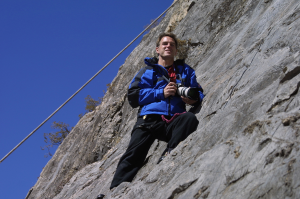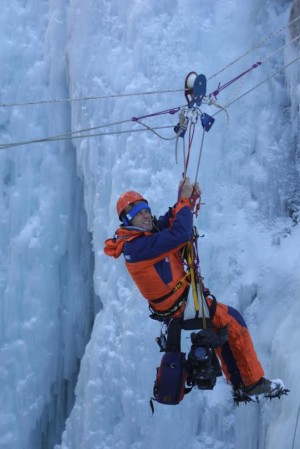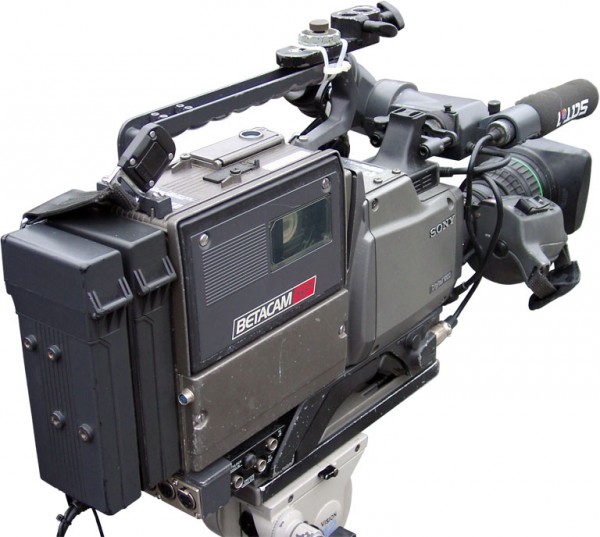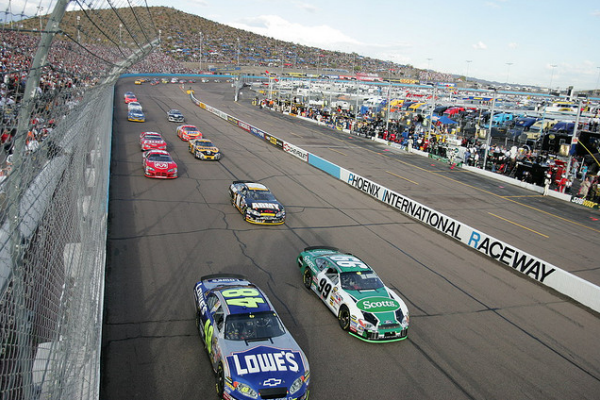One Man’s Journey Making Pictures for Twenty Eight Years
 First I should qualify myself by saying at a ripe young age of just 53 I am a curmudgeon. I shot my first paid images back in the prehistoric days of 1985. That means I survived the entire evolution of analog still cameras with silver halide film to the digital moving images we make with today’s modern video technology. It has occurred to me, it is not necessarily my life in number of years lived, that causes me to be perceived as “an old guy” by some of the young men I work with. It is where I came from and what I have done that makes me prehistoric to them. Trying to explain to a young videographer that I have covered events like the Olympic Games with still cameras that did not require batteries does not provoke the respect one of my experience deserves. Instead, I get the same bewildered and sympathetic response from them I get from my own kids when I tell them I grew up with a black and white TV. They look at me and wonder how this poor old guy survived such astonishingly difficult times. After all, a camera that did not require batteries. That was right after the era when the only way us image makers could express ourselves was by drawing on the wall of a cave with a rock, wasn’t it?
First I should qualify myself by saying at a ripe young age of just 53 I am a curmudgeon. I shot my first paid images back in the prehistoric days of 1985. That means I survived the entire evolution of analog still cameras with silver halide film to the digital moving images we make with today’s modern video technology. It has occurred to me, it is not necessarily my life in number of years lived, that causes me to be perceived as “an old guy” by some of the young men I work with. It is where I came from and what I have done that makes me prehistoric to them. Trying to explain to a young videographer that I have covered events like the Olympic Games with still cameras that did not require batteries does not provoke the respect one of my experience deserves. Instead, I get the same bewildered and sympathetic response from them I get from my own kids when I tell them I grew up with a black and white TV. They look at me and wonder how this poor old guy survived such astonishingly difficult times. After all, a camera that did not require batteries. That was right after the era when the only way us image makers could express ourselves was by drawing on the wall of a cave with a rock, wasn’t it?
In the early eighties I studied photography. My library was filled with books about light, composition, art, and technology. The art books often had pictures of scantily clad women. The technology I studied was about things like lenses. I had to wrap my head around strange phenomena that take place inside a lens like big numbers mean small hole, little numbers mean big hole, small hole means big depth of field, big hole means no depth of field, etc. etc, etc. But a man will endure a lot of learning to take pictures of scantily clad women for a living.
To summarize my early years in the dark ages, it went like this… I never did find myself surrounded by beautiful models taking their clothes off. But my career path did take me down the next best road: sports. I was fortunate enough to work for the United States Ski Team and many other good clients. By the time my still cameras became Digital SLRs, I ran the photo department at a NASCAR race track for five years. So I went around the world a few times and scratched out a living. All in all, a pretty good ride, but the winds of change were blowing. Batteries were replacing brains and technology was compensating for a lack of talent. The sky wasn’t falling but the day rates were. It was time to change or die. Extinction was not going to happen to me.
Over the course of those years I had also been working in video. Moving pictures would become my salvation from extinction. I ditched the still cameras and focused on my video work. In those days the entire professional video world revolved around the Betacam format. So I honed my skills with the big heavy cameras until I found myself at the end of a rope, literally. For recreation I was a little bit of a mountaineer and climber. That, combined with my experience as a Betacam operator worked for Sony Motion Pictures, Television Division. Before I knew it I was dangling from a rope, high in the Rocky Mountains, with two hundred feet of air and a frozen river below me. I was shooting a reality TV show. The twenty pound Betacam was a far cry from a Nikon F3. The first big evolution in my career had taken place. But I was far from riding off to Hollywood with endless calls to work in television.
To understand the industry, you must understand freelancing. First: there is nothing free about it. It is a career path that requires constant hard work, whether you are working or not. A freelancer follows the money. Like a nomad he goes wherever someone is willing to pay him for his craft. So, unlike traveling around to world class sporting events or working in television, my hunter / gatherer instincts had led me to also shoot in the corporate world. That is where I always found meat and potatoes for the table. From the beginning and to this day, most of the checks that feed my children have company names on them that could be recognized more readily on the New York Stock Exchange instead of the credits at the end of a broadcast.
The long reign of the Betacam was about to end with and industry changing event. Video signals recorded to tape went digital and digital video changed everything. Up until this point amateurs and professionals had been separated primarily by one thing, about a half million dollars worth of gear. Seemingly overnight the industry exploded. Several things happened at once and creating a professional looking video product was no longer ground held exclusively by big budget production houses. Small inexpensive digital video cameras could record images rivaling the image of the mighty Betacam. Beefed up home computers could edit this video in place of the old, expensive, and slow linear systems. In short, now anyone with just several thousand dollars to invest, instead of a half million dollars could become a full blown video producer. A cottage industry grew faster than a wildfire in the Hollywood hills. Business cards rolled off presses with self proclaimed titles like Producer, Director, and Camera Guy. I have a few of my own.
There was money to be made and money to be spent. Manufacturers went to work flooding the market with arms for these new rebel shooters. Soon there was a weapon to meet the needs of every shooter. Somewhere in the dark, backrooms of these manufacturing facilities secret plans were being made. Men in suits were discussing things like price points, release dates, and proprietary configurations to capture and hold their market share. Digital video cameras in MiniDV and DVCAM flooded the market.
About this time, some guy in Texas put something up on the World Wide Web for these cottage industry rebels to read. It originally claimed to be an information source for cameras from just one of the manufactures. But it grew rapidly and the original alias it started with was soon changed. Now everyone interested in digital video could participate. This new place on the internet would eventually evolve into a community of 30,000 registered, rebel shooters, called DVINFO.net. It is a very, very strange community. Technically it is a forum for discussion of a common interest, but this one is different than most. This guy in Texas realized that to keep thousands of rebels from different factions civilized it would have to be governed in some way. Rebels don’t like to be governed, and the internet is full of trolls and know-it-alls. He achieved self governance with a stroke of genius. He made it a real names forum. If you are going to join this community you must give up your rebel identity and expose who you really are. Your name appears on every post you make. Cowards are not allowed to anonymously hide behind keyboards and stir things up. Trolls are quickly dispatched. No trial, no rights, they are executed immediately, as it should be. And even if a long time curmudgeon like me makes a gnarly post when I am in a bad mood, I get slapped on the keyboard and Hurded back in the right direction by Obstreperous Rex.
These new Mini DV cameras were a dream to work with for those of us that were used to a twenty pound, or much more, Betacam on our shoulder. Somehow, I found myself on the end of a rope again, on another ice covered cliff. This time it was different. Instead of shooting a pilot for a failed reality show I was shooting for my own client, a pharmaceutical company. This time the ante was upped. I not only had to shoot video, I had to capture still photographs that would be published in a national campaign that would include USA Today, the New York Times and numerous magazines with a very high price for a full page bleed. My own goal was to not end up bleeding. So I armed myself with my light and handy Canon XL1, I also chose my Canon EOS 1 still camera because digital still SLRs of the day could not yet compete with the quality of film. I was only going to get one take. We were to go up the cliff once and that was it. Cutaways, tight shots, wide shots, and establishing shots would all have to be done in a single assent. Oh yeah, and I had to get stills of the whole thing worthy of a national print campaign.
 In the world of ice climbing a rope is not there to assist you in the climb. It is there to prevent an unfortunate event called a screamer. A screamer is the sound one makes while plunging to his death from high up places. Climbers depend on their skill as a climber for their safety, not the rope. Depending on a rope, in the hands of another person to keep you alive is you’re back up plan. Hanging from a rope controlled by riggers to keep you alive is a very unnatural place to be in. But, I was there to work and focus on my subject, my safety was in the hands of the riggers. I was to be hoisted up the cliff while shooting, not climbing. This was going to be interesting.
In the world of ice climbing a rope is not there to assist you in the climb. It is there to prevent an unfortunate event called a screamer. A screamer is the sound one makes while plunging to his death from high up places. Climbers depend on their skill as a climber for their safety, not the rope. Depending on a rope, in the hands of another person to keep you alive is you’re back up plan. Hanging from a rope controlled by riggers to keep you alive is a very unnatural place to be in. But, I was there to work and focus on my subject, my safety was in the hands of the riggers. I was to be hoisted up the cliff while shooting, not climbing. This was going to be interesting.
Everything almost went as planned. I was about thirty feet from cresting the top of the cliff. When there was an untimely tug on my rope while I was banging off some still photos. The tug caused one of my crampons to slip and I spun sideways into the ice covered wall. It smashed the Canon XL1 between my rib cage and the wall of ice. I gasped for breath as I watched the entire viewfinder assembly from my video camera do a two hundred foot screamer. I could not scream or cuss at it, I was catching my breath. Fortunately, there were no broken ribs and I was fine. The only thing seriously hurt was my pride and the viewfinder. I had aquired the shots and everyone else was happy. Most of my corporate work is not that much fun, but it is all good work if you can get it.
At this point in my career there had been three major evolutions. I went from still film cameras to Betacam Video. Then from Betacam video to digital video. Cameras, accessories, and editing systems change very quickly. There is always something new coming out. Most of the time you don’t have to have the latest and greatest equipment. The exception to that is this industry is prone to complete evolutionary metamorphoses that change everything over night. You wake up one morning and find out the men in suits in those secret rooms have released something new that renders everything you have invested in useless. Just when we were all getting caught up and comfortable with digital video a brand new format called High Definition Video was thrust upon us. High Definition video was one of those, you must do it to survive in the business changes. It was not optional. After a total industry metamorphous you must replace everything. The new and expensive cameras and equipment you must purchase are presented to us by marketing departments that coin false, feel good terms like “future proof”. Really?
Sometimes it becomes difficult to keep up with all of the technological changes and options facing a small time video producer. So how do you do it? For me and about 30,000 other video guys from all over the world, part of the answer is DVINFO.net. That forum I mentioned, run by a guy in Texas named Chris Hurd. What makes it strange? If you put any 50 of us video guys in a room together we probably could not find more than two things we could all agree upon. Somehow, some way, we all come together in this on line community to help each other out. That does not mean we all agree with each other, but opinions and advice are shared in a reasonably respectful manor. And that is something to say because today’s video producers are not subcategorized just by specialty; it is closer to the truth if you called them factions.
Now I am going to fast forward to current times. Standard definition video is still out there to a small extent but our video world it pretty much all High Definition. Video tape is dead; most of us shoot almost exclusively to file based media. So, are all of us video guys using the same cameras and formats now? Far from it. Those men in suits, in the secret rooms stay very busy and make sure that will never happen. There are countless choices we must make about cameras, lenses, formats, accessories, editing platforms and many other things. It is more complicated and technical than ever. The choices we make and the systems we use are often what divide video guys into factions. These factions from all over the world communicate with each other at DVINFO.net.
Sometimes the decisions made in those secret rooms at the manufacturing facility create huge, unexpected consequences that even the men in suits don’t expect. In recent years they accidentally created a new faction among video guys. Canon cameras decided to add HD video capability to one of the Digital Single Lens Reflex still cameras they offer. I have no doubt in my mind it was intended to be just another feature to make the expensive camera more attractive to potential buyers ie: still photographers. But everything went crazy again. Some video guys embraced it because it offered three things not commonly found at the time in camcorders, interchangeable lenses, a big sensor, and easy control over depth of field. Never mind the fact that early versions completely overheated and melted down after every five minute video clip. Never mind the fact that all it had for audio was a 1/8 inch mini jack input. Never mind the fact that it was a still camera and the form factor had nothing to do with shooting video. For the new “DSLR Video Guy” these things could be overcome. The cameras were purchased by video guys who previously had no interest in still cameras. To make up for all of the camera’s short comings as a video camera the accessory industry has enjoyed a windfall making aftermarket gadgets to make these things at least semi-functional. The “DSLR” crowd is generally a young group and they ate this up. Like a kid with a hot rod they buy everything you can bolt on to one of these things. The more stuff you have on it to fix the short comings, the cooler it is to them. The goal is to reach a place where you can hardly tell there is a camera in the middle of their contraption. They don’t call it a camera anymore. It is proudly referred to as their “RIG.” These rigs often end up looking like something from a bad science fiction movie. They run around looking like they have a jet pack on with no rocket on their back. It does not look like a video camera because it is not one. But don’t tell them that. In one section at DVINFO.net they will violently defend their choice of tools they use to shoot video and in another section they ask questions like “how can I record quality audio?”
But that is not all that happened when they put video recording in a still camera. Those cameras were originally intended for the professional still photographer. So wave after wave of still photographer began offering video services just because his camera could now make his pictures move. That was all well and good except there was also something else on the still photographer’s new camera that bothered him. It was that 1/8th inch hole that said audio. What is that for they wondered?
Everything got turned upside down. What was once, a clear line in the sand between still photographers and videographers became a place of confusion. Video guys are buying still cameras and still shooters became video guys. The video guy was busy trying to make a still camera a video camera and the still guy was trying to figure out what audio was. This camp threw 50 years of video camera ergonomics and development straight out the window.
So again, DVINFO.net is where everyone goes to sort all this out. It is a very technical place. You can go there for help with any technical issue you might be struggling with. Videography requires the use of both hemispheres of the brain. It is as technical as it is creative. In the long list of dedicated sub forums not one is dedicated to composition, or any of the arts involved in picture making. This forum is where you can keep up with our rapidly changing world of information and technology. These guys would rather discuss pixels and data rates over scantily clad women.
What other factions are at DVINFO.net? I will touch on a few of them.
There is the “toy faction.” These guys are more into the cameras and accessories than shooting with them. It is all about the gun and not the hunt for these guys. They are easy to spot. If you go to their web site, right on the home page you will see a picture of their camera, not a picture they took with it. Some will go as far as adding the list of technical specifications for it. They have not figured out that a client is hiring a videographer, not a camera. Most people looking to hire a videographer have already made the assumption that anyone selling his services as a professional will be professionally equipped. Even though that is not always the case. These guys usually are pretty well equipped because they will buy the latest and greatest even if the previous one has not achieved a proper return on the investment. The men in suits in the secret rooms love these guys.
Then there are the indie film makers and wanna bees. There is only one Steven Spielberg in Hollywood but there are thousands of guys that wanna be him. I have to hand it to these guys. If there is any faction among us that is paying attention to the art of photography it is these guys. They know if they are going to make a film worthy of watching, it needs to be entertaining and well shot. They know how to shoot. Not only that, they may be the smartest crowd in video land because many of them have never been paid to shoot a video. They keep their day job and shoot video for the sheer pleasure of it. The irony of this group is, they have been trying to make a video camera something it is not. A film camera. They spend tons of money and energy seeking a holy grail. They desperately want their video cameras to achieve something elusive called the “film look”. It will never happen because it is not a film camera. All the while, with their heads buried in the technology, they failed to notice Hollywood is giving up on film and is shooting video.
There are also the brand loyal guys. They actually keep up with new model releases from manufacturers they would never support. They do this so they can stand on their stump and join in on the multitudes of conversations about “which one is better?” A Sony only guy, or a Canon only guy, will defend his allegiance to the death. They take it all very personally. Just like every Mac evangelist is pissed off because he knows his choice will never play nice with the rest of the kids on the block. So he waits for the opportunity to argue with any PC user he can attack. A Sony loyalist loves to argue with the Canon or Panasonic guys. Usually no blood is shed and no minds are changed. They just waste a lot of bandwidth but it makes them feel good.
Then there are the mystery men. These guys are the cream of the crop at DVINFO. Why a mystery? Because they participate in the purest sense of what the message board is for. The sharing of information. They skip the community part. But they succinctly fire off accurate and intelligent information. Like the writers behind Wikipedia, they are a dry wealth of knowledge. You will never be able to form an impression of the personality behind the post. It is a public forum and they know it. So they stay safe but grace the rest of us with complex answers to the most difficult of technical dilemmas. They are awesome.
I would be remiss if I did not mention DVINFO.nets one man faction. Don Bloom in Chicago is so unique he is a category of his own. There is a bit of humor in almost everything he writes. But there is more to him than that. He is like a master Ninja. If you upset him he will cut you in half, but what makes him a true master is he does it with a smile on his face. Most don’t see it coming. And the truly ignorant don’t even know they were cut.
What does all of this mean? I have poked a little fun at my colleagues at DVINFO.net. In reality, batteries cannot replace brains and technology cannot replace talent. If that is what you are relying on you won’t make it very far. We are image makers. First and foremost the quality of our product does not come from the tool we hold in our hands. That is a myth. The impact of the final image we deliver comes from within us as photographers. It is a combination of the left brain, right brain coming together to create something that is provocative to a viewer. It comes from a place that is tangible science on one side and indefinable talent on the other. Technology can be learned, talent cannot be taught from a book. Talent can be nurtured, and introduced to a student, but in the end, it will be the photographers own level of talent that will define his ability, not the technology.
 This industry has been good to me. It has allowed me to earn a living showing up at airports to go to work instead of a cubby hole at 8:00 AM. I have been able to eat steak when I wanted, but there has been times when the only thing on my grocery list was Top Ramen. A busy freelancer gets hired and fired more times in a year than most people do in a lifetime. Living without job security is a way of life. My fulfillment comes from the places I have been and the people I meet. I have covered everything from the Olympic Games to the Sundance Film Festival. I have interviewed everyone from Jeff Gordon to Jeff Bridges. That sounds good, but the vast majority of people in front of my camera are names no one will ever know. They are physicians and business people, not celebrities. It does not matter to me who the subject is. Because I am a freelancer. Any day I am working is a good day.
This industry has been good to me. It has allowed me to earn a living showing up at airports to go to work instead of a cubby hole at 8:00 AM. I have been able to eat steak when I wanted, but there has been times when the only thing on my grocery list was Top Ramen. A busy freelancer gets hired and fired more times in a year than most people do in a lifetime. Living without job security is a way of life. My fulfillment comes from the places I have been and the people I meet. I have covered everything from the Olympic Games to the Sundance Film Festival. I have interviewed everyone from Jeff Gordon to Jeff Bridges. That sounds good, but the vast majority of people in front of my camera are names no one will ever know. They are physicians and business people, not celebrities. It does not matter to me who the subject is. Because I am a freelancer. Any day I am working is a good day.
So what would I have to say to those young guys that think I am old? First, I am not old. I could still shoot from the end of a rope if I needed to. Here is some quick advice learned over thirty years. Making it in this business is not a onetime event, it is a lifelong process. Love your job, not the equipment, breaking up is expensive and it is going to happen a lot. There is no such thing as future proof. Always remember you are selling your talent, not a camera. Freelancing is harder work when you’re not working than it is when you’re working hard. The cardinal sin of freelancing is trying to steal someone’s client while you are working for him. Repeat business will come to you based on how you do business, not just how well you shoot. Audio is as important as video. Never hit on a riggers wife, he may be holding your rope on the next gig. If you know it all, you are a lot smarter than me, I am still learning. And lastly, never forget, old guys rock!
All photos on this page (with three exceptions that are hopefully obvious) are the copyright of the author.







